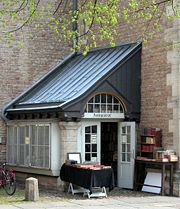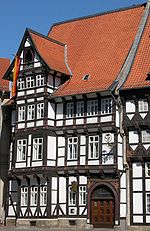Burgplatz (Braunschweig)
| Burgplatz | |
|---|---|
| Place in Braunschweig | |
 Burgplatz from the town hall tower , looking northwest |
|
| Basic data | |
| city | Braunschweig |
| District | Downtown |
| Newly designed | 1937 |
| Confluent streets | In front of the castle |
| Buildings | Antiquarian bookshop on Burgplatz, Brunswick Cathedral, Dankwarderode Castle, Huneborstelsches Haus, Deutsches Haus, former Dompredigerhaus, Veltheimsches Haus, Vieweg-Haus |
| use | |
| User groups | Pedestrian zone, theater performances, events, Christmas market |
 Map of the Burgplatz |
|
The Burgplatz in Braunschweig , as its historical and geographical center, is an ensemble of great historical and cultural importance. Today it is one of the five so-called " traditional islands " of the city.
Spatial arrangement of the buildings on and around Burgplatz
| Huneborstelsches house | |||
| Veltheim's house | Hotel German House | ||
| Vieweg house |

|
Antiquarian bookshop on Burgplatz , Dankwarderode Castle in front of the Braunschweiger Löwe |
|
| Brunswick Cathedral | |||
history
Since the 9th century, the prince's seat of the Brunones , designed as a flatland castle, has been located here on a natural Oker island . In the 12th century, Duke Heinrich the Lion expanded Burgplatz into the center of Guelph power. The Burgplatz, today bordered by the palas of the former Dankwarderode Castle , the Brunswick Cathedral , the classical Vieweghaus and the Veltheim House and the Huneborstel House , still shows the medieval floor plan. The Brunswick lion has been at the center of the square since around 1166 .
Today's situation around Burgplatz is significantly different from that in the time of Henry the Lion. Until the late 19th century, the area was bordered to the east by the Oker; today there are roads with large public buildings. A flat extension of the lower terrace, which pushed forward into the swampy floodplain, gave the location of the castle and collegiate church. The ditch that separated the headland in the west has disappeared, as has the defensive wall around the area. The Veltheimsche Haus from 1573 is evidence of the noble courts in the north as a later descendant. The imposing church and the canons' houses outside the Burgplatz to the south-west remain of the buildings of the St. Blasii Monastery ( Brunswick Cathedral ) .
The main building of the castle, which occupies the east side of the square, is a new building from the years 1887 to 1889. With the utmost generosity one can say that it is similar to the buildings of Henry the Lion. The wing on the side of the monastery is a historicizing fantasy, the highlight of which is the deliberate ruin architecture on the southeast corner. An elevated transition to the collegiate church has been proven by the findings of the wall there.
What structural conditions Heinrich the Lion found in the castle area can no longer be specified due to a lack of sources. A fortification has been excavated on the west side, parts of which can still be dated to the 10th century. Around 1030 a collegiate monastery was founded as the burial place of the Brunonengrafen. The place came through marriage connections to Emperor Lothar , then to his grandson and heir Heinrich the Lion.
Only a few reliable findings are available about the chronological order of the measures. Since 1173 the collegiate church has been rebuilt from scratch and by Heinrich's death in 1195 it had grown to the tower. According to the chronicler Albert von Stade, the duke had the extraordinary statue with the once gilded lion erected around 1166. The mighty castle palace, to which the castle chapel and the living quarters adjoined, could already have existed at this point in time. When the English king's daughter Mathilde was brought to Braunschweig as the wife of the duke in 1168 , this indicates that the representative buildings were largely completed.
The secured facts include the dimensions of the two-story hall building with around 40 meters, more than in most of the royal palaces. It is doubtful whether the individual forms are derived from the Goslar imperial palace . The castle chapel, however, shows striking similarities with the (also excavated) northern palatine chapel in Goslar. It should be added that the expansion to the center of power was not limited to the castle, but also included generous support for bourgeois settlements. Carefully estimated, the settlement area increased threefold. From here the city of Braunschweig rose to become a metropolis in the north of Germany.
After the end of the Middle Ages, the importance of the Burgplatz sank to the point of insignificance. With the exception of von Veltheimsche Haus, the north side was basically only equipped with makeshift buildings; the castle had been converted into a barracks and stood there as a ruin after a fire in 1873, which the city fathers wanted to be demolished at the end of the 19th century after citizen protests did not happen. With the construction of the Vieweghaus and, much later, the rebuilding of the Palas of the castle, the square was revived. The creation of today's ensemble came to an end with the relocation of the Huneborstel House from Sack around the turn of the century and the establishment of the Hotel Deutsches Haus.
The buildings on Burgplatz were largely spared from the heavy bombing raids of World War II. The palace hall of the castle alone received several direct hits and the cathedral was only slightly damaged on the roof and on some of the windows compared to the surrounding city center, which was 90% destroyed.
In more recent times, Burgplatz was a busy road that formed a traffic island around the lion statue. In the course of the redesign of the cathedral to the so-called “National Consecration Place” by the National Socialists , the Burgplatz received the paving of red and occasionally green Beucha granite porphyry with particularly rough and uneven stone surfaces, which is still visible today .
use
The Burgplatz is used in a variety of ways, in summer for example for performances by the Braunschweig State Theater with a temporary stage and auditorium. The Braunschweig Christmas market takes place regularly on Burgplatz and adjacent squares .
Antiquarian bookshop on Burgplatz

The smallest antiquarian bookshop in Germany was built in 1949 to the left of the entrance to Dankwarderode Castle. It has a floor area of around 8 m². Its founder was the writer Wilhelm Scholz , it was continued from 1930 to 1992 by his colleague Bernhard Schütte. The second-hand bookshop has been under new management since 1992.
literature
- Uwe Beitz: To decorate the city. Building history of the Brunswick Burgplatz since 1750 . Friedrich Vieweg & Sohn, Braunschweig / Wiesbaden 1989, ISBN 3-528-08732-3 , pp. 142 ( books.google.de - excerpt).
- Peter Giesau: Burgplatz. In: Luitgard Camerer , Manfred Garzmann , Wolf-Dieter Schuegraf (eds.): Braunschweiger Stadtlexikon . Joh. Heinr. Meyer Verlag, Braunschweig 1992, ISBN 3-926701-14-5 , p. 53-54 .
- Jürgen Hodemacher : Burgplatz. In: Braunschweig's streets - their names and their stories. Volume 1: Inner City. Elm-Verlag, Cremlingen 1995, ISBN 3-927060-11-9 , pp. 88-89.
- Wolfgang Kimpflinger: Monument topography Federal Republic of Germany , architectural monuments in Lower Saxony. Volume 1.1 .: City of Braunschweig, Part 1. Hameln 1993, ISBN 3-87585-252-4 , pp. 49-68.
- Jürgen Mertens: The Burgplatz at the end of the 16th century (= work reports from the Braunschweig Municipal Museum . Volume 28 ). Municipal Museum, Braunschweig 1978, OCLC 251759989 .
- Reinhard Roseneck : The classicist plans for the Brunswick Burgplatz. In: Lower Saxony State Administration Office - Institute for Monument Preservation (Ed.): The Vieweg House in Braunschweig. (= Workbooks on the preservation of monuments in Lower Saxony. No. 5), Hagemann, Hildesheim 1985, ISBN 3-88079-009-4 , pp. 47–62.
Web links
- All around the cathedral and Burgplatz braunschweig.de
Individual evidence
- ↑ Heinz Eichhorn: Bernhard Schütte - From the life of the oldest Braunschweiger bookseller in the smallest antiquarian bookshop in the Federal Republic. In: Braunschweigischer Kalender 1989. Verlag Joh. Heinr. Meyer, Braunschweig 1988, p. 36.
- ^ Ernst Bergfeld: Antiquarian and writer. On the 20th anniversary of the death of Wilhelm Scholz (1863–1939). In: Friends of the Great Orphanage. Issue 27, Braunschweig 1959, p. 9.
Coordinates: 52 ° 15 ′ 53 ″ N , 10 ° 31 ′ 25 ″ E








